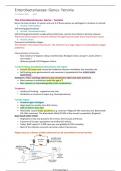Lecture notes
Enterobacteriaceae genus - Yersinia
- Institution
- University Of Surrey (UNIS)
Detailed exploration of Yersinia morphology, structure, and classification within the Enterobacteriaceae family. Insight into the mechanisms of infection, virulence factors, and the host immune response to Yersinia infections. Comprehensive discussion on the symptoms, diagnosis, and treatment...
[Show more]



